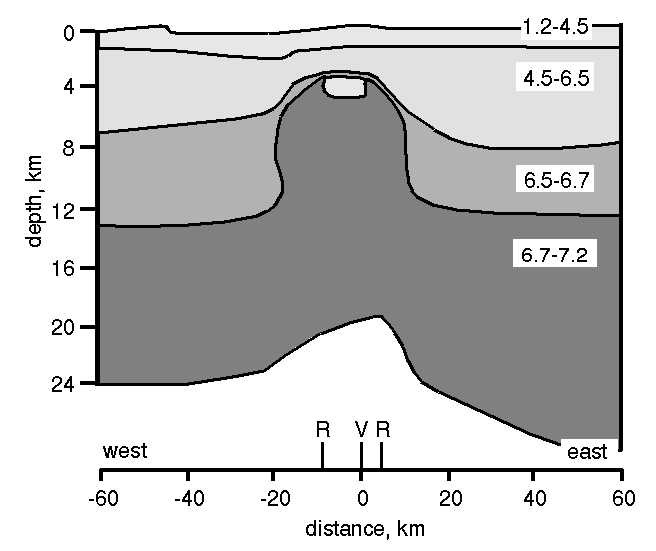Faroes-Iceland Experiment - 2: Structure of the Krafla Central Volcano
B. Brandsdottir, W. Menke, P. Einarsson, R. White and R. Staples
J. Geophys. Res. 102, 7867-7886, 1997
Abstract
The seismic vekocity of the Krafla central volcano is characterized by large variations in
compressional velocity. A 40 km wide high-velocity dome extends from the lower crust
(11-14 km depth) beneath the volcano narrowing upwards. A magma chamber sits at its top
near 3 km depth. It is defined bu both 0.2-0.3s compressional wave delays and shear
wave shadowing to be 2-3 km NS, 8-10 km EW and 0.7-1.8 km thick. The near-surface structure
(uppermost 2.5 km) of the Krafla caldera is approximately flat-lying, with only minor lateral
heterogeneities. The crust beneath the magma chamber has low shear wave attenuation and
anomalously high compressional and shear wave velocities. Shear waves, reflected from a 19 km deep
Moho, are clearly visible for some paths through the crustal volume below the magma chamber,
even though the more shallow-diving S waves are severely attenuated. The mid-crust beneath
the shallow magma chamber cannot contain partial melt or even be at near-solidus temperatures.
The Krafla central volcano plays a major role in crustal genesis along the plate
boundary. The high velocity dome, in our view, represents crust generated in and around
the magma chamber, which has subsequently nem advected to greater depths.

Crustal strucure of the Krafla central volcano. Two dimensional EW compressiona
velocity model derived from traveltime data.
Text
Figures
- Fig. 1. Map of the Krafla central volcano. (PostScript version).
- Fig. 2. P wave traveltime curves and 1D compressional velocity
model for shallow structure of caldera. (PostScript version).
- Fig. 3. P wave seismograms for shallow caldera structure.
A) Observed, trace normalized amplitudes. B) Observed, section normalized amplitudes. C)
Predicted, from 1D model. (PostScript version).
- Fig. 4. S wave sesimograms for shallow caldera structure.
A) Observed, section normalized amplitudes. B) Predicted from 1D model with Vp/Vs=1.76
and low attenuation in low-velocity layers. C) Predicted, high attenuation layers. (PostScript version).
- Fig. 5. Traveletime data and predicitions (Solid, this study; dotted,
Arnott & Foulger's [1994a] model). (PostScript version).
- Fig. 6. Record sections for P wave from distant explosion undershooting Krafla. (PostScript version).
- Fig. 7. Record sections showing P and PmP arrivals. (PostScript version).
- Fig. 8. Earthquake in Axarfjordur recorded at Askja. (PostScript version).
- Fig. 9. Record sections for P wave from distant explosion undershooting
region just west of Krafla. (PostScript version).
- Fig. 10. Record sections showing P and PmP and S and SmS.
(PostScript version).
- Fig. 11. Shear wave shadows under Krafla. (PostScript version).
- Fig. 12. P and S waves from a distant earthquake undershooting Krafla.
A) Observed S wave. B) Observed P wave. C)Predicted S wave, using 2D model with shallow magma
chamber and high-velocity dome. (PostScript version).
- Fig. 13a. Crustal strucure of the Krafla central volcano. Two dimensional EW compressiona
velocity model derived from traveltime data. (PostScript version).
- Fig. 13b. Crustal strucure of the Krafla central volcano. Two dimensional NS compressiona
velocity model derived from traveltime data. (PostScript version).
- Fig. 13c. Traveltime data and fits. (PostScript version).
- Fig. 14. P wave traveltime anomaly associated with high-velocity dome.
(PostScript version).
- Fig. 15. Predicted P wave from a distant earthquake undershooting Krafla.
A) Vertical incidence, chimney (dome) only. B) Vertical incidence, both chimney and magma chamber.
C) Oblique incidence, chimney only. D. Oblique incidence, both chimney and magma chamber.
(PostScript version).

